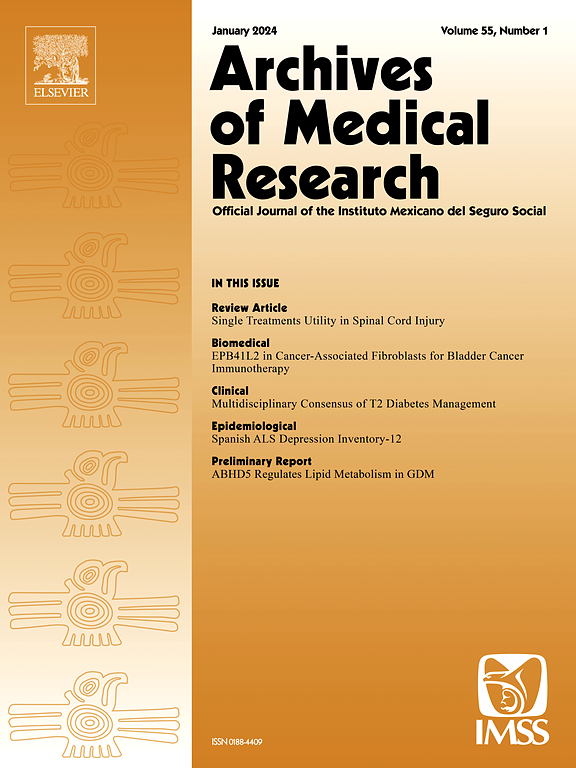白血病 B 细胞缺乏 miR-155 会导致细胞周期停滞和 MIR155HG/TP53INP1/CDKN1A/CCND1 网络失调
IF 4.7
3区 医学
Q1 MEDICINE, RESEARCH & EXPERIMENTAL
引用次数: 0
摘要
背景细胞周期的进展和白血病的发生是一个受到严格调控的过程,在这个过程中,即使细胞周期调控分子和微RNA(miRNA)的表达出现微小的失衡,也会导致癌症/白血病发生风险的增加。在这里,我们重点研究了一种无处不在、多功能的致癌 miRNA-hsa-miR-155-5p(miR-155,MIR155HG),它在包括慢性淋巴细胞白血病(CLL)在内的恶性肿瘤中过度表达。然而,miR-155 如何调节白血病细胞的细胞周期的确切机制仍是广泛研究的主题。方法我们通过 CRISPR/Cas9 编辑了 CLL 细胞系 MEC-1,在 MIR155HG 基因中引入了一个短缺失。为了描述 miR-155 缺陷细胞中转录组和 miRN 组水平的变化,我们进行了 mRNA-seq/miRNA-seq 分析,并通过 qRT-PCR 验证了这些变化。流式细胞仪用于测量细胞周期动力学。WST-1检测法、血细胞计数器和Annexin V/PI染色法评估了细胞活力和增殖情况。与此同时,细胞周期负调控因子 p21/CDKN1A 和细胞周期蛋白 D1(CCND1)也出现了过表达。我们证实了典型的 miR-155 靶点如 PU.1、FOS、SHIP-1、TP53INP1 的过表达,并揭示了新的潜在靶点(FCRL5、ISG15 和 MX1)。我们的 CLL 模型对于进一步研究操纵 miRNA 水平将高侵袭性白血病细胞逆转为近似良性或非白血病类型很有价值。本文章由计算机程序翻译,如有差异,请以英文原文为准。
Deficiency of miR-155 in leukemic B-cells results in cell cycle arrest and deregulation of MIR155HG/TP53INP1/CDKN1A/CCND1 network
Background
Cell cycle progression and leukemia development are tightly regulated processes in which even a small imbalance in the expression of cell cycle regulatory molecules and microRNAs (miRNAs) can lead to an increased risk of cancer/leukemia development. Here, we focus on the study of a ubiquitous, multifunctional, and oncogenic miRNA-hsa-miR-155–5p (miR-155, MIR155HG), which is overexpressed in malignancies including chronic lymphocytic leukemia (CLL). Nonetheless, the precise mechanism of how miR-155 regulates the cell cycle in leukemic cells remains the subject of extensive research.
Methods
We edited the CLL cell line MEC-1 by CRISPR/Cas9 to introduce a short deletion within the MIR155HG gene. To describe changes at the transcriptome and miRNome level in miR-155-deficient cells, we performed mRNA-seq/miRNA-seq and validated changes by qRT-PCR. Flow cytometry was used to measure cell cycle kinetics. A WST-1 assay, hemocytometer, and Annexin V/PI staining assessed cell viability and proliferation.
Results
The limited but phenotypically robust miR-155 modification impaired cell proliferation, cell cycle, and cell ploidy. This was accompanied by overexpression of the negative cell cycle regulator p21/CDKN1A and Cyclin D1 (CCND1). We confirmed the overexpression of canonical miR-155 targets such as PU.1, FOS, SHIP-1, TP53INP1 and revealed new potential targets (FCRL5, ISG15, and MX1).
Conclusions
We demonstrate that miR-155 deficiency impairs cell proliferation, cell cycle, transcriptome, and miRNome via deregulation of the MIR155HG/TP53INP1/CDKN1A/CCND1 axis. Our CLL model is valuable for further studies to manipulate miRNA levels to revert highly aggressive leukemic cells to nearly benign or non-leukemic types.
求助全文
通过发布文献求助,成功后即可免费获取论文全文。
去求助
来源期刊

Archives of Medical Research
医学-医学:研究与实验
CiteScore
12.50
自引率
0.00%
发文量
84
审稿时长
28 days
期刊介绍:
Archives of Medical Research serves as a platform for publishing original peer-reviewed medical research, aiming to bridge gaps created by medical specialization. The journal covers three main categories - biomedical, clinical, and epidemiological contributions, along with review articles and preliminary communications. With an international scope, it presents the study of diseases from diverse perspectives, offering the medical community original investigations ranging from molecular biology to clinical epidemiology in a single publication.
 求助内容:
求助内容: 应助结果提醒方式:
应助结果提醒方式:


